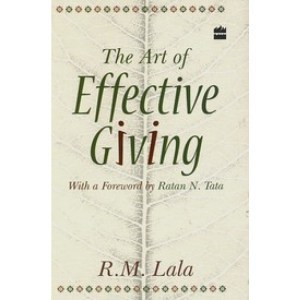Raj Shankar's Blog, page 60
February 2, 2013
Interesting Links This Week: 03-Feb-2013
Here are the favourite links of this week from my list – somehow the 2 of the top 3 have been on funding:
Great avenue for funding especially for startups and small business owners: http://www.nytimes.com/2013/01/06/business/crowdfunding-for-small-business-is-still-an-unclear-path.html?smid=tw-share&_r=1&
As we enter the second month we may still want to watch out for these. Here is what the VCs have to say about what 2013 could hold for us http://www.inc.com/eric-markowitz/bold-predictions-from-the-worlds-top-vcs_pagen_2.html
Why blogging is essential if you want to establish leadership and expertise http://blogs.hbr.org/cs/2012/12/if_youre_serious_about_ideas_g.html?utm_campaign=Socialflow&utm_source=Socialflow&utm_medium=Tweet


February 1, 2013
Books and Me: The Art of Effective Giving
Title: The Art of Effective Giving
Author: R.M.Lala
There are many reasons why we may want to pick up this little gem on giving.
Reason #1 : The book is attractively packaged by the publishers. The size, the cover, the layout and the print, make the book irresistible, especially if you are looking for an easy read.
Reason #2: The title is interesting enough to elicit attention. It immediately raises some questions in one’s mind like is giving an art? What is effectiveness in giving? What is the art in effective giving? Is it really possible to teach giving? I am sure each of us will have our own list. The above ran in my head influencing me to pick it up.
Reason #3: With eleven books to his credit , the author R M Lala is not an unknown name amongst Indian Writers. Most of us may have read and been impacted by one of his earlier writings. My personal favourite which also introduced me to the author was the title ‘Beyond the Last Blue Mountain’. If you are a fan of the Tatas and their legacy there is probably no one who has written more on them than this man. This book also has an interesting foreword written by Ratan Tata, which seals the case for picking this book
The book is divided into two broad parts, with the first dedicated to personalities and the second to principles. Both parts have short chapters with specific and focused writing. The personalities section speaks about Bill and Melinda Gates and Warren Buffet, Andrew Carnegie, Sir Jamsetjee JeJeebhoy, Jamsetji Tata, Sir Dorabji Tata, Sir Ratan Tata and Azim Premji. The second part discusses giving at the level of an individual, instituition and how to widen the group of people who give.
In today’s world where the number of charities and foundations are on the rise and the voice to make the world better is becoming louder this book provides ample suggestions on all aspects of giving. As I complete this blog post, I wonder why I should build a case for someone to be reading a book on giving. And the below quote present towards end of the book captures why every one of us should understand giving better “We make a living by what we get, but we make a life by what we give.” – Winston Churchill


Workshop at the 7th ISBA Conference, 7th Feb 2013
 This year has been interesting and the first month was filled with great opportunities to talk and work on business models and firm strategies. Thoroughly enjoyed the interactions and thought share.
This year has been interesting and the first month was filled with great opportunities to talk and work on business models and firm strategies. Thoroughly enjoyed the interactions and thought share.
This month starts with yet another exciting event. Indian Science and Technology Entrepreneurs Parks and Business incubator Association (ISBA) is a body set up to promote incubation activities. Will be at there at their 7th ISBA Conference at KIIT University, Odisha http://www.isba2013.in/ for a workshop on ‘Designing Profitable Business’ http://isba2013.in/pdf/ISBA_2013_PROGRAMME.pdf gives the conference agenda
Looking forward to meeting many from the incubator, STEP and accelerator community apart from ofcourse the entrepreneurs. Sure to come back with a lot of fresh perspectives to act and share!


January 31, 2013
On Entrepreneurship: Idea or Opportunity?
I was sitting earlier this week with two other faculty planning our sessions for a three day workshop in entrepreneurship that we are co-leading for the students of a leading business school in India. As we were discussing the flow, we were often bringing up experiences and feedback from our earlier sessions. One thing that we all agreed was the importance of making the participants learn / relearn / reinforce / recollect / remember – the difference between an idea and an opportunity.
we are co-leading for the students of a leading business school in India. As we were discussing the flow, we were often bringing up experiences and feedback from our earlier sessions. One thing that we all agreed was the importance of making the participants learn / relearn / reinforce / recollect / remember – the difference between an idea and an opportunity.
An opportunity arises in the market. It is the result of any change happening in the social domain.
An idea is a thought that arises in the mind of an individual. Every thought is an idea. Some ideas inspire us while some even drain us! And most of them don’t become successful businesses! While some succeed with an idea, other fail with the same idea. Why?
Opportunities are also similar. There are many opportunities around us, especially today. All seemingly lucrative and luring. But then why is it that only few people are able to commercialize an opportunity successfully, while many others fail in their attempts?
One of the key reason is the inability to understand that ideas and opportunities are different. And one needs a formidable combination of these two to make good sense in business. Any of these in its absolute is just a parameter. An idea or an opportunity by itself is like an incomplete piece of a puzzle, waiting for the corresponding right piece to fit in. However in our impatience for action, we tend to make our moves the minute we feel we hold one piece in our hands. In our eagerness we forget however great the piece we hold looks, without its counterpart it is an incomplete puzzle of little use to anyone. We proceed with this one piece; only to fail.
We can argue endlessly which makes a better starting point – an idea or an opportunity? Any argument is only relative. Undeniably it is the combination that determines the success of your business. Let’s not forget that!


January 30, 2013
On Innovation: Failing Early Through Experimentation
Any organization wanting to tap into the power of innovation has to be willing to develop the mindset of accepting failure.  If managers do not develop a mindset for this, most innovation efforts / programs will die in their infancy. The reason being, nobody wants to be looked upon as the person who failed. But most are fine if they are seen as people whose experiments didn’t work out. Understanding this difference can have a large impact on your innovation program.
If managers do not develop a mindset for this, most innovation efforts / programs will die in their infancy. The reason being, nobody wants to be looked upon as the person who failed. But most are fine if they are seen as people whose experiments didn’t work out. Understanding this difference can have a large impact on your innovation program.
When managers leading the innovation program are able to set clear and short experiments, incremental in nature and building just a little on the previous step – failure when it happens becomes a part of the process. It does not get too much attention. This allows the team to tweak the experiment if required and take another attempt at it. Innovation programs, then must incorporate experimentation as a way of nurturing creativity and enthusiasm amongst employees to participate.
As against this imagine a program structured to run as a big-bang process, where on selection of an idea, the attempt is to run it end to end on a single run. What would happen if this fails? What could be the impact commercially and on the psyche of the team behind the idea? Will it encourage others to try? Will it encourage the firm to stay on its course of searching for the NEXT idea?
Failing early provides for better utilization of resources, efforts and most importantly enthusiasm. The next time you hear about organizations discussing innovation as an important aspect of growth – check if there are enough opportunities for failing early in the program. If not the program is bound to fail!


Release Of Report On Innovation
WILL INNOVATION BE THE REAL GAME CHANGER FOR THE INDIAN CORPORATE?
INNOVATION is the lever that companies are looking to for giving turnaround results. Apart from interest, a lot of time, effort and money are being invested by corporate on their innovation programs. However our survey indicates corporate are far from happy with the outcome of the innovation program. Low employee engagement, quality of ideas, alignment issues and sustainability of the program are key challenges. Read this ichiban INSIGHTS report on the impact of innovation programs and the Six Point Anchor that can catalyze better returns
Click here to download a free copy of the report http://www.ichibangroup.in/ir/ichiban_research_reports.php?status=1
To free subscriptions to reports from ichiban INSIGHTS drop a mail with the email id to insights@ichibangroup.in with subject line SUBSCRIBE


January 29, 2013
Vedantic Wednesday: Difference Between The Seer And The Seen
Earlier we had discussed that our spiritual journey starts with a seed of a small  doubt http://rajshankar.wordpress.com/2013/01/23/vedantic-wednesday-the-first-doubt/ The doubt that the ‘I’ we know is separate from the visible physical identity. That we could possibly be something other than our body.
doubt http://rajshankar.wordpress.com/2013/01/23/vedantic-wednesday-the-first-doubt/ The doubt that the ‘I’ we know is separate from the visible physical identity. That we could possibly be something other than our body.
Many of our spiritual texts work relentlessly to make this point – it is stated as an aphorism, it is written down as the rules, it is hidden in stories, it is present in soulful hymns. But to little avail – we remain firm on the belief that we are our body! And the masters do not give up – they try and make it easier for us.
One of the logic that they put in front of us for consideration is the difference between the seer and the seen. All of us are familiar with the fact that subject and object are two different entities. This is mentioned in Vedanta as ‘drg-drsya-viveka’. Literal translation of this Sanskrit phrase is ‘the seer subject is different from the seen object’. You are convinced when you see a chair – you and chair are different. You are not the chair. When you see a tree – you are sure you and the tree are different. One can go on giving further proofs to this statement that seer and seen are different.
Now lets extrapolate this – you see your body. In which case case ‘you’ the subject has to be different from ‘your body’ the object. So Vedanta asks how you can say you are the body? It urges you to think – can you then be something other than the body?
In this logic there is a childlike simplicity. It seems so obvious. But as adults we just cannot accept this. This is because from birth we are conditioned to relate to our body.
So while we may try to shout this down – Vedanta only tells us to consider if there could be any chance that we are not our body?


January 28, 2013
On Strategy: Figuring Your Formula
When one builds an institution especially a startup – they don’t want anything mundane or repetitive. But the truth is, if you  want to build an enterprise you need to find something that is repeatable. If you cannot find that one thing that your organization can do repeatedly in a profitable manner – you will find yourself doing a lot of interesting work without really making much money.
want to build an enterprise you need to find something that is repeatable. If you cannot find that one thing that your organization can do repeatedly in a profitable manner – you will find yourself doing a lot of interesting work without really making much money.
Repeatability, may mean different things for different enterprises. Can Apple only work on creating new models and not look at ways to efficiently and effectively mass-produce and sell the products? How is Apple able to repeatedly figure out new devices that we all get addicted to? Even in the most creative enterprises around the world, there is repeatability but in a more subtle manner.
In everything that happens in nature, there is a pattern. Venture creation is no exception. However what gets celebrated is the creative side of business. Only if you can offer in a consistent manner (repeatable) the creative solution, will you have a sustainable enterprise. A good entrepreneur is one who looks for repeatability in the solutions, services or products he thinks of offering. For that is the secret formula of a successful business.


On Leadership: Goldfish Have No Hiding Place
No this is not a review of James Hadley Chase book !!
Very often the reason why students want to take up Entrepreneurship is because of the (mis)understanding of what it means to be a leader. We often hear that they want to become CEOs because they do not want to listen to someone giving them orders; they want to lead and not follow. They believe they can experience freedom when they lead. The exhilaration of having lesser people above you is what makes leadership positions covetable to many from a distance even in a corporate setting.
However leaders will tell us this is far from reality. While as you ascend, your reporting hierarchy does get reduced – but the span to whom you are accountable and responsible for increases. You realize while earlier you had to listen only to your boss – now you have to listen to your board, your client, your vendors, your teams, your peers, your family and worst of all to your inner voice that constantly pushed you to achieve this position.
Not only do people have very less tolerance to mistakes you commit – your every action becomes more visible. You feel a hundreds eyes are on you – you need to be now leading by example and there is no room here for a slip. It does sound scary and morbid. But a seasoned leader (rather a person seasoned for the leadership role) takes it in their stride. These constraints instead of fatiguing them, builds within them the discipline and self control. The very chains that seem to tie down the leadership spirits – become the fire that polishes the gold.
When we were discussing this with a group of business unit heads in our recent training, a participant said this reminds him about the James Hadley Title “Goldfish have no hiding place” but he also added “It is better to be a brilliant goldfish than an unknown fish!!”


January 26, 2013
Interesting Links This Week: 27-Jan-2013
Here are my this week’s favorites:
A peek into the challenges and motivations of the Tech Startups in Africa: http://knowledge.wharton.upenn.edu/article.cfm? articleid=3166
articleid=3166
Could this become the future of public libraries. After reading it I had a mixed feeling from the ease of access on going digital and the losing of the touch and feel of physical books http://www.theverge.com/2013/1/13/3872478/americas-first-bookless-public-library-will-look-like-an-apple-store
This could be happening right here. College students face many adjustment issues. Balancing the need to earn a living and the desire to get educated, the sudden change from vernacular medium to English, the exposure to city and multi culture environment as they step out of their smaller towns.. We need solutions to these and many more http://www.nytimes.com/2012/12/23/education/poor-students-struggle-as-class-plays-a-greater-role-in-success.html?hp&_r=1





